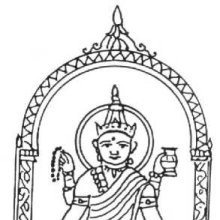Bahurupin, Bahurupini, Bahu-rupini, Bahurūpin, Bahurūpiṇī, Bahu-rupin: 5 definitions
Introduction:
Bahurupin means something in Hinduism, Sanskrit, Jainism, Prakrit. If you want to know the exact meaning, history, etymology or English translation of this term then check out the descriptions on this page. Add your comment or reference to a book if you want to contribute to this summary article.
Images (photo gallery)
In Hinduism
Shaktism (Shakta philosophy)
Source: Google Books: ManthanabhairavatantramBahurūpin (बहुरूपिन्) refers to “(the Vidyā) of many forms”, according to the second recension of the Yogakhaṇḍa of the Manthānabhairavatantra, a vast sprawling work that belongs to a corpus of Tantric texts concerned with the worship of the goddess Kubjikā.—Accordingly, “In the meantime, once the goddess had crossed over the most excellent Yoga and once the fifth night had passed, she emerged from the middle of the Liṅga. [...] She (also has other forms with) two or six arms and, beautiful, sits on five ghosts. In the left hand (she holds) a skull and (in her other) upraised hands (she holds a) noose and spear. Crooked, her body grey, she is Cāmuṇḍā, the accomplished Yoginī. This Vidyā, of many forms [i.e., bahurūpiṇ—vidyeyaṃ bahurūpiṇī], is the woman who resides within the Triangle. Such is the visualized form of the goddess, the deity called Khageśī”.

Shakta (शाक्त, śākta) or Shaktism (śāktism) represents a tradition of Hinduism where the Goddess (Devi) is revered and worshipped. Shakta literature includes a range of scriptures, including various Agamas and Tantras, although its roots may be traced back to the Vedas.
In Jainism
General definition (in Jainism)
Source: archive.org: The Jaina IconographyBahurūpiṇī (बहुरूपिणी) or Naradattā is the name of the Yakṣiṇī accompanying Munisuvrata: the twentieth of twenty-four Tīrthaṃkaras or Jinas, commonly depicted in Jaina iconography.—The Jaina texts furnish the emblem of a tortoise which differentiates the image of this Jina from those of all the rest. The Yakṣa husband and wife are called Varuṇa and Naradattā (Digambara Bahurūpiṇī) respectively. The king who plays the part of his Chowri-bearer is named Ajita. The tree made sacred by being associated with the scene of his Kevala knowledge is Campaka.
Naradattā is described in the Śvetāmbara literature as seated in the Bhadrāsana posture, showing four hands which hold Varada, rosary, citron, and trident (or urn). The Digambara Yakṣiṇī is represented by them as riding a black snake and holding a shield, fruit, sword and Varada-mudrā. Naradattā or Bahurūpiṇī from the nature of her symbols and her husband’s being of Śaivite character, discloses herself in representation as a form of Durgā or a Brahmanic Śakti. The Yakṣiṇī element in her may be clearly attested by the symbol of the fruit citron and the urn, the true attribute of the wife of Varuṇa. It should be noted in this connection that this Naradattā and the predefined Puruṣadattā, the Yakṣiṇī of Sumatinātha, being the same in meaning suggest some mysterious common origin.
Source: archive.org: TrisastisalakapurusacaritraBahurūpiṇī (बहुरूपिणी) or Bahurūpā is the name of a Vidyā, according to the Jain Ramayana and chapter 7.7 [The killing of Rāvaṇa] of Hemacandra’s 11th century Triṣaṣṭiśalākāpuruṣacaritra: an ancient Sanskrit epic poem narrating the history and legends of sixty-three illustrious persons in Jainism.—Accordingly, “Wounded in his heart very much by their speech about the return of Sītā, as if struck in a vital spot, Daśamukha reflected for a long time. Having decided in his heart on the subjugation of the vidyā Bahurūpā, Rāvaṇa, his passions subdued, went to Śrī Śānti’s shrine. [...]”.

Jainism is an Indian religion of Dharma whose doctrine revolves around harmlessness (ahimsa) towards every living being. The two major branches (Digambara and Svetambara) of Jainism stimulate self-control (or, shramana, ‘self-reliance’) and spiritual development through a path of peace for the soul to progess to the ultimate goal.
Languages of India and abroad
Sanskrit dictionary
Source: Cologne Digital Sanskrit Dictionaries: Monier-Williams Sanskrit-English DictionaryBahurūpin (बहुरूपिन्):—[=bahu-rūpin] [from bahu > bah] mfn. = -rūpaka mfn., [Bhāgavata-purāṇa]
Sanskrit, also spelled संस्कृतम् (saṃskṛtam), is an ancient language of India commonly seen as the grandmother of the Indo-European language family (even English!). Closely allied with Prakrit and Pali, Sanskrit is more exhaustive in both grammar and terms and has the most extensive collection of literature in the world, greatly surpassing its sister-languages Greek and Latin.
Kannada-English dictionary
Source: Alar: Kannada-English corpusBahurūpiṇi (ಬಹುರೂಪಿಣಿ):—
1) [noun] a woman who acts in different roles (in a drama).
2) [noun] a woman who performs acrobatics.
3) [noun] (jain.) an accomplishment by which a person can assume any form at will.
Kannada is a Dravidian language (as opposed to the Indo-European language family) mainly spoken in the southwestern region of India.
See also (Relevant definitions)
Partial matches: Bahu, Rupini, Rupi.
Full-text: Bahurupe, Naradatta, Bahurupa, Munisuvrata, Ajita.
Relevant text
Search found 4 books and stories containing Bahurupin, Bahurupini, Bahu-rupini, Bahu-rūpin, Bahurūpin, Bahurūpiṇī, Bahu-rupin, Bahu-rūpiṇī, Bahurūpiṇi, Bahurupene, Bahurūpeṇe, Bahu-rupene, Bahu-rūpeṇe; (plurals include: Bahurupins, Bahurupinis, rupinis, rūpins, Bahurūpins, Bahurūpiṇīs, rupins, rūpiṇīs, Bahurūpiṇis, Bahurupenes, Bahurūpeṇes, rupenes, rūpeṇes). You can also click to the full overview containing English textual excerpts. Below are direct links for the most relevant articles:
Jain Remains of Ancient Bengal (by Shubha Majumder)
The twenty-four Tīrthaṅkaras and their Yakṣas and Yakṣiṇīs < [Chapter 6 - Iconographic Study of Jaina Sculptural Remains]
Trishashti Shalaka Purusha Caritra (by Helen M. Johnson)
Part 7: Defeat and death of Rāvaṇa < [Chapter VII - The killing of Rāvaṇa]
Jainism in Odisha (Orissa) (by Ashis Ranjan Sahoo)
Iconography of Sasanadevis < [Chapter 6]
Iconography of Jain Gods and Goddess < [Chapter 6]
Secular and Religious Figurines and Motifs in Jain Art < [Chapter 5]
The Devi Bhagavata Purana (by Swami Vijñanananda)
